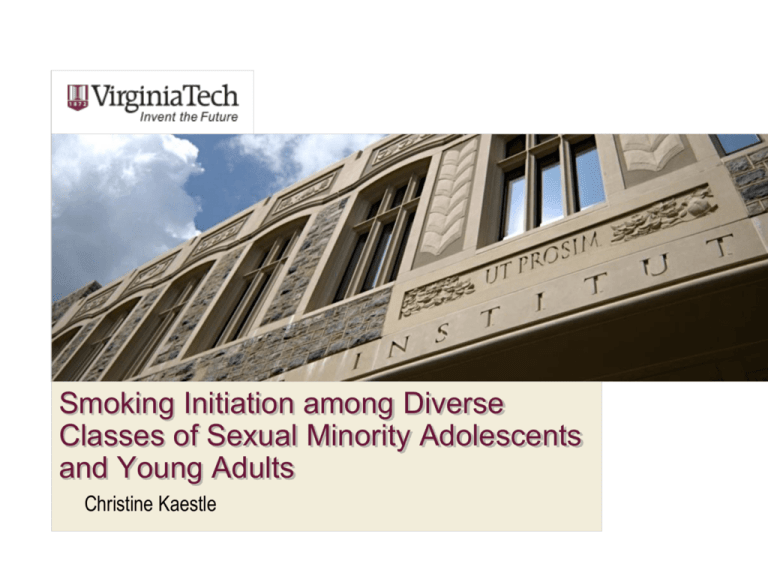Smoking Initiation among Diverse Classes of Sexual Minority
advertisement

Smoking Initiation among Diverse Classes of Sexual Minority Adolescents and Young Adults Christine Kaestle Tobacco industry targets sexual minorities 2 Controversies • Smoking research has profoundly neglected sexual minority groups • Most tobacco surveillance data does not include sexual orientation • Even less info on diversity and resilience factors • Invisibility of sexual minorities in tobacco prevention interventions 3 Controversies • Apparent contradictions and debate over extent of health inequities • large discrepancies • magnitude • consistency 4 My Research Questions • Are sexual minority youth more vulnerable to smoking initiation? • Are risks unevenly distributed across sexuality and racial and ethnic subgroups in systematic ways? • Can protective factors have amplified effects for some subgroups compared to others? 5 • Data from Waves I through IV • Nationally representative • Grades 7-12 in 1995 (Wave I) • In-home, computer-assisted questionnaires • Wave IV in 2009 (ages 24-32) • About 10,000 participated in all waves Measuring critical concepts • Age of smoking milestones • Sexual orientation 7 Timing of initiation: Importance • Timing of smoking initiation • Younger → higher rates of lung cancer • Younger → increased dependence • Younger → decreased cessation • I explored longitudinal reports of initiation timing in my first of a series of manuscripts from this study… 8 Timing of initiation: Telescoping • I found increased ages of smoking in later reports: • Average increase of about 2 years • ¼ had increased age of daily smoking by 4 years • Forward telescoping: over time, people reduce their estimate of elapsed time since an event. • In a longitudinal or retrospective study, using later data will result in substantially later onset age reports. 9 Kaestle, C. E. (in press) Age of smoking milestones: Longitudinal inconsistencies and recanting. Journal of Adolescent Health. Timing of initiation: Bias • What predicts smoking reporting inconsistencies and recanting in longitudinal data? • More inconsistencies and recanting: those who started younger, African American, Latino, and Asian respondents, males. • Not associated: depression, same-sex attractions or relationships, and family structure. • Stability of reports of adolescent smoking is biased by age of onset, sex, and race. • Should use reports that are most proximal to initiation. 10 Kaestle, C. E. (in press) Age of smoking milestones: Longitudinal inconsistencies and recanting. Journal of Adolescent Health. Operationalizing Sexual Minority Status Orientation measures often used alone in research Reconceptualized as Multidimensional Sexual orientation identity most common; omits those who engage in same-sex sexual behavior but do not self-identify as a sexual minority Same-sex relationship behaviors more concrete behavioral definition, but it limits the sample to those who have had the opportunity to engage in same-sex behavior Same-sex romantic attractions avoids missing youth who feel attracted to the same sex but have not had an opportunity to act Self-Label Orientation Identity Romantic Attraction Sexual Behavior Longitudinal Latent Class Analysis • Person-centered approach • Incorporates multiple dimensions: • self-labeling • relationship behavior • attraction • Identifies subgroups with unique patterns over time 12 LLCA: 8 Classes Class sexually active heterosexuals late bloomer heterosexuals mid bloomer heterosexuals mostly hetero identity emerging bisexuality asexual sexually active homosexuals 13 later-blooming non-heterosexual Description opposite-sex partners, opposite sex attraction, hetero identity no sex and no attractions build to opposite-sex partners, attractions, and hetero identity opposite-sex attraction throughout but oppositesex partners start later, hetero identity attract to opposite, opposite-sex partners, but mostly hetero identity growing levels of both-sex activity and attractions, identity is mostly hetero or bisexual abstains from sex, fewer attractions reported, hetero, mostly hetero, or no orient identity same-sex attractions, same-sex partners, and homosexual identity increasing spectrum of identity and behavior LLCA: 8 Classes sexually active heterosexuals mid bloomer heterosexuals emerging bisexuality sexually active homosexuals late bloomer heterosexuals mostly hetero identity asexual later-blooming non-heterosexual 16.2 30.2 5.5 15.1 3.5 3.2 1.5 1.4 38.6 14 Survival Analysis: Age of Initiation Asexual Late het Mid het Late non-het Active hom Active het Bisex Mostly het 15 Survival Analysis: Age of Initiation Active het Active hom Bisex 16 Survival Analysis: Age of Initiation Asexual Late het Mid het Active hom Active het Bisex 17 Survival Analysis: Age of Initiation Asexual Late het Mid het Late non-het Active hom Active het Bisex Mostly het 18 Diverse Population • Racial and Ethnic Heterogeneity • minority social identities interact • racism within LGBT communities • heterosexism within racial/ethnic communities • different smoking initiation patterns? 19 Race: White Only Asexual Late het Mid het Mostly het 20 Late non-het Active het Active hom Bisex Race: African-American Only Asexual Mid het Late het Late non-het Active het Bisex Mostly het Active hom 21 African-American and White Active het, Black Active hom, Black Active het, White Active hom, White 22 Social Support as a Buffer? • Stress and Social Support • Why do some youth exposed to stress do better than others? • Resiliency and protective factors • Social support protects people from stressful events by helping them cope • Buffer negative impacts of stress on health related outcomes 23 Mentor Role Example Active het, Black, Mentor Active het, Black, NO Mentor Active hom, Black, NO Mentor Active hom, Black, Mentor 24 Conclusions • Sexual minority subgroups experience different smoking initiation patterns • Sexual minority status interacts with race/ethnicity to shape these patterns • Social support, such as mentors, can attenuate the effect of sexual minority status for some subgroups 25 Discussion • Solves contradictions in literature • Timing • Measurement • Shows early and cumulative disparities • Prevention policy must address • Informs the targeting and customizing interventions to unique subgroups • Diversity: orientation, race, and resources 26 Future Research • Systematic review of smoking prevention interventions for sexual minority youth • VT graduate students Danielle Liggett and Hoa Nguyen • Drugs, discrimination, and resilience among gay men • Dr. Anthony Lyons at LaTrobe University, Melbourne • Utility of the Theory of Planned Behavior to predict short-term and long-term smoking and alcohol outcomes: A cross-national study • Dr. John Toumbourou at Deakin University, Melbourne • Population Assessment of Tobacco and Health (PATH) 27 Thank You



